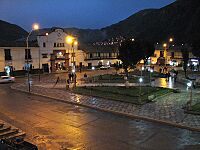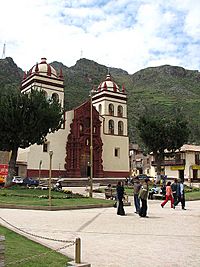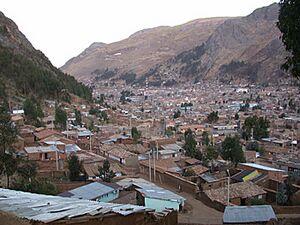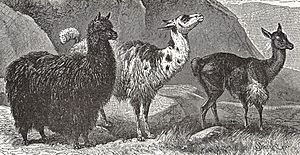Huancavelica facts for kids
Quick facts for kids
Huancavelica
|
|||
|---|---|---|---|
|
City
|
|||
|
Plaza de armas of Huancavelica at night, The cathedral of Huancavelica.
|
|||
|
|||
| Nickname(s):
"Villa Rica de Oropesa"
|
|||
| Country | |||
| Region | Huancavelica | ||
| Province | Huancavelica | ||
| Founded | 5 August 1572 | ||
| Founded by | Francisco de Toledo | ||
| Area | |||
| • Total | 514.10 km2 (198.50 sq mi) | ||
| Elevation | 3,676 m (12,060 ft) | ||
| Population
(2017)
|
|||
| • Total | 49,570 | ||
| • Estimate
(2015)
|
47,866 | ||
| • Density | 96.421/km2 (249.729/sq mi) | ||
| Demonym(s) | Huancavelicano(a) | ||
| Time zone | UTC-5 (PET) | ||
| • Summer (DST) | UTC-5 (PET) | ||
| Website | www.munihuancavelica.gob.pe | ||
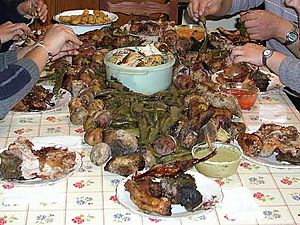
Huancavelica (Spanish pronunciation: [waŋkaβeˈlika]), also called Wankawillka in Quechua, is a city in Peru. It is the capital city of the department of Huancavelica. In 2017, about 49,570 people lived there.
The city was officially started on August 5, 1572, by Francisco de Toledo, who was the Viceroy of Peru. Many Indigenous peoples live in Huancavelica. The city is very high up, about 3,676 meters (12,060 feet) above sea level. The weather is cold and dry from February to August, and it rains a lot from September to January.
Contents
Geography and Landscape
The area around Huancavelica has a very rugged landscape. The land goes from low valleys at 1,950 meters (6,398 feet) to tall, snow-covered mountains over 5,000 meters (16,404 feet) high. These mountains are part of the western Andes mountain range.
Some of the highest mountains in the area include Sitaq (5,328m), Wamanrasu (5,298m), and Altar (5,268m). Several important rivers flow through the region, such as the Mantaro, the Pampas, the Huarpa, and the Churcampa. The Pampas River starts in the high mountain lakes of Huancavelica, like Chuqlluqucha and Urququcha.
History of Huancavelica
Before the Spanish arrived, the Huancavelica region was known as Wankawillka, meaning "sacred stone." The city itself was founded on August 5, 1572, by Francisco de Toledo, who was the viceroy of Peru. The community has grown a lot since then.
The Mercury Mines
In the 1560s, valuable mercury deposits were found in Huancavelica. The Spanish Crown took control of these mines in 1570 and ran them until Peru became independent in 1821. These mines were very important because mercury was needed to extract silver from ores. This process was used in silver mines across Peru and in Potosí (which is now in Bolivia).
Working in the mercury mines was extremely difficult and dangerous. To get enough workers, the Viceroy Francisco de Toledo brought back and improved an old Inca system called the mita. This was a mandatory service where people had to work in the mines for a certain period.
Because of the discovery of mercury, a hill near the city became very famous. This led Viceroy Francisco de Toledo to establish the city in 1572, naming it Villa Rica de Oropesa. In 1648, the Viceroy of Peru said that Potosí (for silver) and Huancavelica (for mercury) were "the two pillars that support this kingdom and that of Spain."
In more recent times, Huancavelica faced challenges and didn't progress as fast as other parts of Peru. However, the government is now paying more attention to the city, and things are starting to improve.
A special wedding song sung by a young girl from this region was even included on the Golden Record. This record was sent into space on the Voyager 1 and Voyager 2 probes in 1977, carrying sounds and images from Earth for any intelligent life that might find them.
Climate
| Climate data for Huancavelica (elevation 3,717 m (12,195 ft), (1991–2020 normals) | |||||||||||||
|---|---|---|---|---|---|---|---|---|---|---|---|---|---|
| Month | Jan | Feb | Mar | Apr | May | Jun | Jul | Aug | Sep | Oct | Nov | Dec | Year |
| Mean daily maximum °C (°F) | 16.4 (61.5) |
15.9 (60.6) |
15.7 (60.3) |
15.8 (60.4) |
16.6 (61.9) |
16.7 (62.1) |
16.7 (62.1) |
17.4 (63.3) |
17.2 (63.0) |
17.6 (63.7) |
19.0 (66.2) |
16.9 (62.4) |
16.8 (62.3) |
| Mean daily minimum °C (°F) | 3.8 (38.8) |
3.8 (38.8) |
3.7 (38.7) |
2.6 (36.7) |
0.7 (33.3) |
−0.2 (31.6) |
−0.1 (31.8) |
0.6 (33.1) |
2.3 (36.1) |
3.0 (37.4) |
3.4 (38.1) |
3.7 (38.7) |
2.3 (36.1) |
| Average precipitation mm (inches) | 153.7 (6.05) |
166.6 (6.56) |
155.8 (6.13) |
70.7 (2.78) |
21.1 (0.83) |
10.7 (0.42) |
16.7 (0.66) |
25.6 (1.01) |
50.5 (1.99) |
72.3 (2.85) |
71.9 (2.83) |
131.2 (5.17) |
946.8 (37.28) |
| Source: National Meteorology and Hydrology Service of Peru | |||||||||||||
Getting Around
You can travel to and from Huancavelica by bus. There are paved roads connecting the city to Huancayo and Lima. Another road links it to the coastal city of Pisco. Buses leave from the bus station on the west side of the city.
Huancavelica also has a train service that runs between it and Huancayo. This train is famously known as "el Tren Macho." People jokingly say it "leaves when it wants and arrives when it can," because it's not always on a strict schedule. In 2010, the train line was updated to a standard gauge, making it more modern.
Education
Huancavelica is home to the National University of Huancavelica. This university also has campuses in other cities within the region. Another university, the University for Andean Development (Universidad para el Desarrollo Andino), is located in Lircay, which is about an hour away from Huancavelica. There are also other schools for technical training, like the Technological High Institute and the Instituto Superior Pedagogico.
Places to Visit
The city has many old buildings from the colonial period. There are eight churches located throughout the city. The most important one is the cathedral, which stands in the main square. Another interesting place to visit is the former Santa Barbara mine. It's about three kilometers (nearly 2 miles) from the city. This mine was very famous during colonial times for its mercury extraction.
The main sports stadium in Huancavelica is the IPD Stadium. It is one of the highest sports stadiums in the world, located at 3,676 meters (12,060 feet) above sea level. It can hold about 2,500 people.
Notable People
- Patricia Benavides (born 1969) - A lawyer who became Peru's attorney general in June 2022.
Images for kids
-
This geologic map shows the area around Huancavelica. The Santa Bárbara mine is at the bottom center, south of the city.
See also
 In Spanish: Huancavelica para niños
In Spanish: Huancavelica para niños


